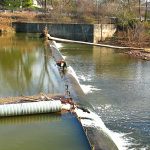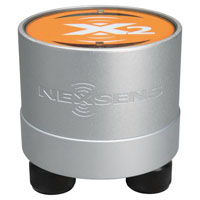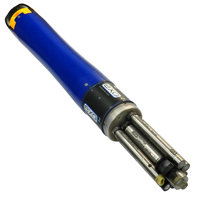
 In the early 1900s, the Hoover brothers developed water treatment methods to reduce typhoid, a prevalent illness during that era. Columbus gained national prominence in the water quality industry as a result. Since then, water quality monitoring of the Scioto River and Big Walnut Creek has been an integral part of the drinking water treatment process at the Columbus Water Treatment Plants.
In the early 1900s, the Hoover brothers developed water treatment methods to reduce typhoid, a prevalent illness during that era. Columbus gained national prominence in the water quality industry as a result. Since then, water quality monitoring of the Scioto River and Big Walnut Creek has been an integral part of the drinking water treatment process at the Columbus Water Treatment Plants.
The Scioto River begins as a small creek about 80 miles north in Hardin County, northwest of Kenton, Ohio. Running through woods and farmlands, this river remains a main water source for Columbus. The Griggs and O’Shaughnessy reservoirs, located on the Scioto River, have a combined storage capacity of 6.2 billion gallons, holding only a small percentage of the water that flows through Columbus and provide water for downtown, west, and northwest Franklin County.
Big Walnut Creek forms about 20 miles northeast of Columbus and feeds Hoover Reservoir, named after the Hoover brothers. This reservoir can hold 20.8 billion gallons of water; it supplies water for the entire northeast portion of Franklin County.
To ensure drinking water met quality standards, public utilities officials asked NexSens Technology to supply and install real-time source water monitoring systems that would monitor water quality along the Hoover, Griggs, and O’Shaughnessy Reservoirs.
Real-time reservoir data
 NexSens applications engineers installed two NexSens cellular data telemetry systems at drinking water intakes — one near the Hap Cremean Treatment Plant and one near the Griggs Treatment Plant — to allow city personnel from the water quality assurance laboratory to monitor the water quality constantly. YSI sondes with temperature, conductivity, pH, dissolved oxygen, turbidity, and chlorophyll sensors are connected to the cellular systems. Data is transmitted at hourly intervals to the lab and posted to a secure website where authorized city employees can access the data 24/7. Graphs, data tables, and statistical reports are available for analysis online.
NexSens applications engineers installed two NexSens cellular data telemetry systems at drinking water intakes — one near the Hap Cremean Treatment Plant and one near the Griggs Treatment Plant — to allow city personnel from the water quality assurance laboratory to monitor the water quality constantly. YSI sondes with temperature, conductivity, pH, dissolved oxygen, turbidity, and chlorophyll sensors are connected to the cellular systems. Data is transmitted at hourly intervals to the lab and posted to a secure website where authorized city employees can access the data 24/7. Graphs, data tables, and statistical reports are available for analysis online.
At Hoover Reservoir, a YSI profiling system measures water quality parameters throughout a vertical column. An integrated winch and drive mechanism automatically raises and lowers the water quality instrument, which traverses the water column four times daily. The water quality instrument, another YSI sonde, measures temperature, conductivity, dissolved oxygen, pH, turbidity, and chlorophyll at one-meter intervals, while an integral pressure sensor records the depth of each measurement.
“The benefits of the platform include improved process control at the plant, chemical cost reductions, security monitoring, and customer satisfaction in taste and odor control,” said Rich Rutherford, water research analyst for the City of Columbus Division of Water. “Additionally, the improved understanding of our reservoir’s limnological life cycle will help to secure its reliable use for future generations in Columbus.”
This ongoing source water monitoring helps ensure Columbus drinking water will be of the highest quality, meeting all EPA and SDWA standards.
The NexSens X2 Environmental Data Logger offers the latest in real-time monitoring technology with wireless communication, large plug-and-play sensor library, and ultra-low power consumption.
The YSI EXO represents the next generation of water quality instruments from YSI. The EXO2 sonde includes six sensor ports and a central anti-fouling wiper option.
WQData LIVE is a web-based project management service that allows users 24/7 instant access to data collected from remote telemetry systems.



